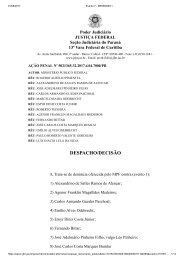Brasil só deve dominar Leitura em 260 anos, aponta estudo do Banco Mundial Relatorio Banco Mundial _Learning
You also want an ePaper? Increase the reach of your titles
YUMPU automatically turns print PDFs into web optimized ePapers that Google loves.
public investment. A central el<strong>em</strong>ent of the program is<br />
the introduction of two additional years of secondary<br />
education, which in turn requires the rehabilitation<br />
and expansion of school infrastructure to provide the<br />
places needed for senior high school. Despite a 19-fold<br />
increase in the infrastructure budget between 2005<br />
and 2015, lack of government capacity to manage<br />
such a massive school building program has meant<br />
that a large share of the resources r<strong>em</strong>ained unspent.<br />
In 2014 only 64 percent of the infrastructure budget<br />
was committed. And even where classrooms were<br />
built, school principals have been largely unsatisfied<br />
with their quality. 14<br />
Spending to improve<br />
learning<br />
Achieving education goals, whether national or<br />
global, will certainly require more spending in the<br />
coming decades. The Education Commission estimates<br />
that low- and middle-income countries will<br />
have to increase spending by 117 percent between<br />
2015 and 2030 to enable most children to complete<br />
primary and secondary education with minimum<br />
levels of learning, as the Sustainable Development<br />
Goals call for. 15 Reliably estimating such global costs<br />
is difficult because <strong>do</strong>ing so requires accurate information<br />
on many aspects of country syst<strong>em</strong>s that is<br />
often unavailable. It also requires making assumptions—for<br />
example, about optimal class size—that,<br />
while valid for some countries, may not apply to<br />
others. Notwithstanding these difficulties, exercises<br />
of this kind offer useful information on what school<br />
expansion of reasonable quality might cost. That<br />
information indicates that, even with greater efficiencies,<br />
it will be impossible to extend schooling for<br />
hundreds of millions of students without investing<br />
more in education.<br />
The key will be to use those additional resources<br />
in ways that improve learning, especially for disadvantaged<br />
children. Costing exercises are sometimes<br />
misinterpreted as implying that more spending is all<br />
that is needed. But because there is no certainty that<br />
spending will lead to better outcomes, spending better<br />
will also be essential—as the Education Commission<br />
<strong>em</strong>phasizes. When education is funded using<br />
resources diverted from other pressing public needs<br />
such as health or infrastructure, or funded through<br />
debt to be repaid by the next generation, it is crucial<br />
that spending be oriented toward what will improve<br />
learning for all. How to achieve this is the focus of this<br />
World Development Report.<br />
Spending more can be an important first step<br />
to spending better, but, again, increasing spending<br />
alone is not sufficient to improve learning. The<br />
politics of education reform sometimes requires<br />
compensating stakeholders who might lose out,<br />
or spending more to lay the foundations for future<br />
reform. For example, addressing the low pay of teachers<br />
in Peru was an important prerequisite for introducing<br />
the reforms (such as linking teacher career<br />
paths to performance) that underpinned improv<strong>em</strong>ents<br />
in learning outcomes. 16 However, in other<br />
cases strategies of this kind have worked less well.<br />
A 2006 education finance law in Argentina aimed at<br />
reversing declines in quality led to a near-<strong>do</strong>ubling of<br />
education spending as a share of GDP (from 3.5 to 6<br />
percent) between 2005 and 2013. The new resources<br />
were used to increase teacher hiring, raise teacher<br />
pay, and improve school infrastructure. Yet despite<br />
these improv<strong>em</strong>ents in inputs, learning outcomes<br />
have improved only marginally in recent years and<br />
are still below 2003 levels. 17 These experiences highlight<br />
the need to strengthen the links in the spendinglearning<br />
chain, if more spending is to lead to better<br />
learning outcomes.<br />
Notes<br />
1. See chapter 9 and Altinok (2010).<br />
2. World Bank (2013b).<br />
3. Glewwe and others (2011).<br />
4. Mbiti, Muralidharan, and Schipper (2016); Pradhan and<br />
others (2014).<br />
5. See Filmer, Hammer, and Pritchett (2000) for a similar<br />
analysis of health spending.<br />
6. World Bank (2016c).<br />
7. World Bank (2016a).<br />
8. See Policy Note 5, figure 8 in World Bank (2016a).<br />
9. Sabarwal, Evans, and Marshak (2014).<br />
10. UIS (2016).<br />
11. Das and others (2013). This may be beneficial if it reduces<br />
financial burdens on parents, but that was not the primary<br />
purpose of these grants.<br />
12. Mbiti, Muralidharan, and Schipper (2016).<br />
13. Pradhan and others (2014).<br />
14. World Bank (2016a).<br />
15. This includes only projected costs of primary and secondary<br />
education. See Education Commission (2016, table 3).<br />
16. Bruns and Schneider (2016).<br />
17. de Hoyos, Holland, and Troiano (2015).<br />
Spending more or spending better—or both? | 187








